Japanese garden designs are a beautiful blend of nature, symbolism, and art, making them a unique expression of tranquility and balance. With elements like carefully placed stones, serene water features, and meticulously pruned plants, these gardens invite contemplation and relaxation. Whether you’re looking to create a miniature version in your backyard or simply appreciate the aesthetics, there’s plenty to inspire your own green space.
Seasonal Planting Schemes
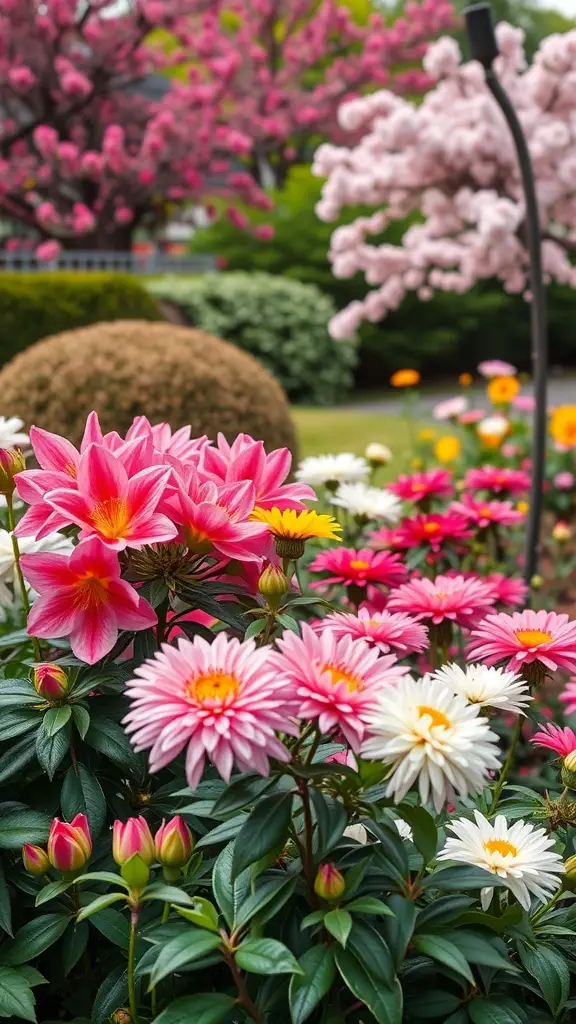
Japanese gardens are known for their stunning seasonal displays. The image shows a vibrant mix of flowers, showcasing the beauty of spring. Bright pink lilies and cheerful daisies create a lively atmosphere, perfect for welcoming the warmer months.
In spring, cherry blossoms often take center stage, adding delicate pink hues to the landscape. The combination of these flowers not only enhances the garden’s aesthetic but also reflects the changing seasons, a key aspect of Japanese garden design.
When planning a seasonal planting scheme, consider using a variety of blooms that will thrive at different times of the year. This way, your garden remains colorful and inviting throughout the seasons. Mixing perennials with annuals can offer a continuous display of flowers, ensuring that there’s always something in bloom.
Incorporating seasonal elements, like lanterns or water features, can also enhance the overall experience. These features can create a serene environment, allowing visitors to enjoy the beauty of nature in every season.
Koi Ponds and Water Features
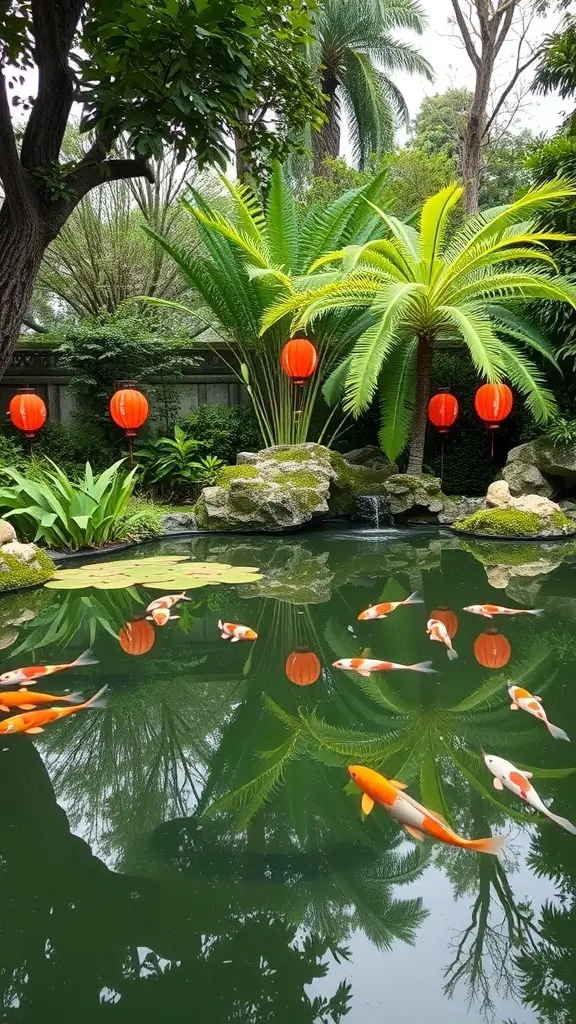
Koi ponds are a stunning feature in Japanese garden designs. They bring a sense of calm and beauty, making any garden feel more serene. The image shows a vibrant pond filled with colorful koi fish swimming gracefully. These fish are not just pretty; they symbolize good fortune and prosperity in Japanese culture.
The lush greenery surrounding the pond adds to its charm. Tall palm-like plants and carefully placed rocks create a natural look. The red lanterns hanging nearby provide a pop of color and a traditional touch, enhancing the overall aesthetic.
Water features, like this koi pond, are essential in Japanese gardens. They reflect the sky and surrounding plants, creating a peaceful atmosphere. The gentle sound of water flowing can be very soothing, making it a perfect spot for relaxation.
Incorporating koi ponds into your garden design can transform your space into a tranquil retreat. Whether you have a large backyard or a small patio, a water feature can bring life and tranquility to your outdoor area.
Bridges and Arches
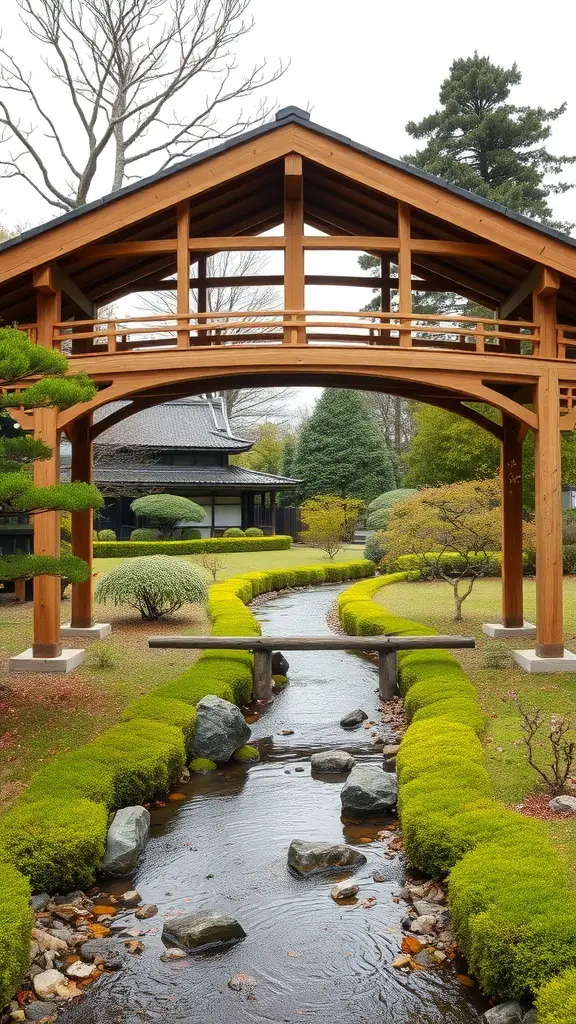
Bridges and arches play a vital role in Japanese garden designs. They are not just functional; they also add beauty and harmony to the landscape. The image shows a stunning wooden bridge that gracefully spans a gentle stream, surrounded by lush greenery.
This bridge connects different areas of the garden, inviting visitors to explore. The design is simple yet elegant, reflecting the natural materials often used in Japanese gardens. The soft curves of the bridge complement the flowing water beneath, creating a serene atmosphere.
In addition to their aesthetic appeal, bridges symbolize the journey from the mundane to the spiritual. Crossing a bridge in a garden can feel like stepping into a different world, one filled with peace and tranquility. The careful placement of such structures enhances the overall experience of the garden.
Overall, bridges and arches are essential elements that bring together nature and design, making Japanese gardens a unique place to relax and reflect.
Tea Garden Elements
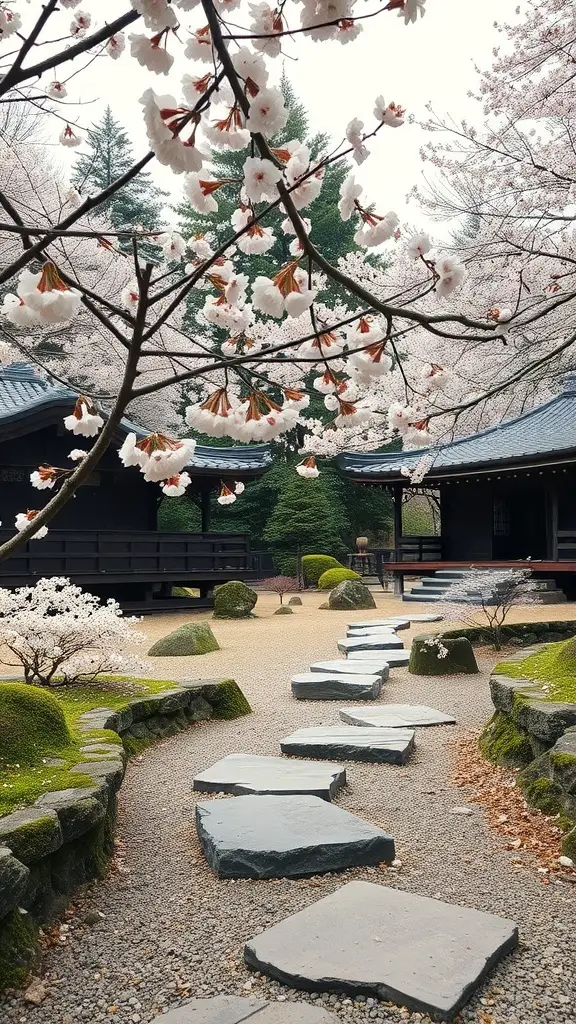
Tea gardens are a special part of Japanese garden designs, focusing on simplicity and tranquility. The image shows a serene path lined with smooth stones, leading through a beautifully arranged garden. This path invites visitors to take a leisurely stroll, allowing them to appreciate the beauty around them.
Cherry blossoms frame the scene, adding a touch of color and a sense of seasonal beauty. These delicate flowers symbolize renewal and are often associated with Japanese culture. The presence of flowering trees enhances the peaceful atmosphere, making it an ideal spot for tea ceremonies or quiet reflection.
The carefully placed rocks and greenery create a harmonious balance, typical of Japanese aesthetics. Each element in the garden serves a purpose, whether it’s to guide the visitor’s path or to provide a visual focal point. This design encourages mindfulness, making it a perfect setting for enjoying a cup of tea.
Bonsai Tree Arrangements
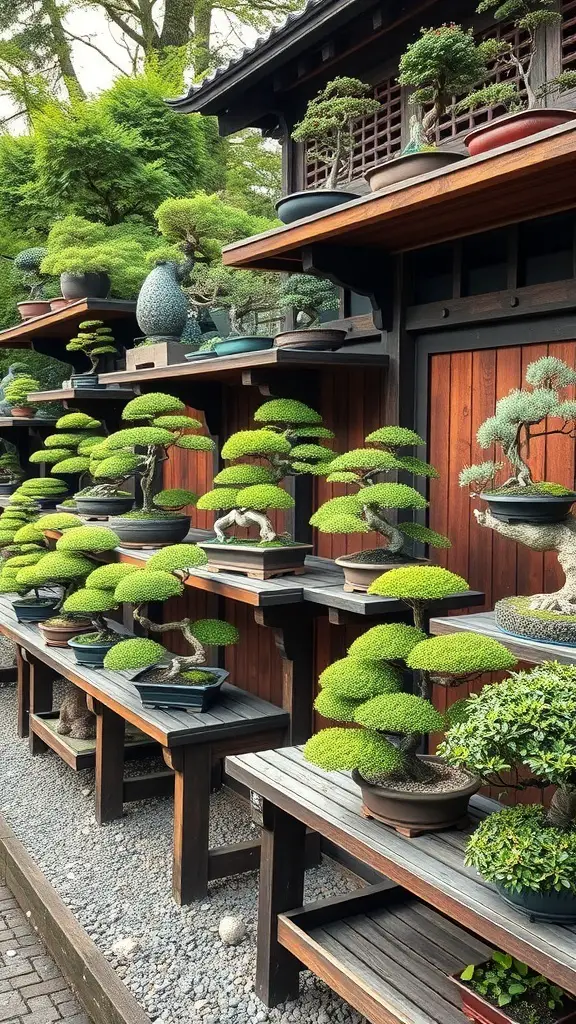
Bonsai trees are a stunning feature of Japanese gardens. They represent nature in miniature, showcasing the beauty of trees in a compact form. The image displays a variety of bonsai trees arranged neatly on wooden shelves. Each tree has its own unique shape and style, making them visually appealing.
The vibrant green foliage of the bonsai contrasts beautifully with the dark wood of the shelves. This arrangement not only highlights the artistry involved in bonsai cultivation but also creates a serene atmosphere. The careful placement of each tree allows viewers to appreciate their individual characteristics.
In a Japanese garden, bonsai trees can serve as focal points or be part of a larger landscape design. They invite contemplation and provide a sense of peace. Whether you’re a seasoned gardener or just beginning, incorporating bonsai into your garden can enhance its beauty and tranquility.
Pathways and Walkways

Pathways in a Japanese garden are more than just routes; they guide visitors through a serene landscape. The image shows a beautifully designed stone path winding its way through lush greenery and colorful flowers. Each step invites you to explore the garden’s hidden gems.
The stones are arranged in a natural pattern, creating a sense of flow. This design encourages a leisurely stroll, allowing you to take in the sights and sounds of nature. The surrounding plants add a splash of color and texture, making the walk even more enjoyable.
Along the path, traditional lanterns stand tall, casting a warm glow as the sun sets. These lanterns not only illuminate the way but also enhance the garden’s charm. They remind us of the cultural significance of light in Japanese gardens.
Overall, the pathways and walkways in a Japanese garden create a peaceful atmosphere. They invite you to slow down, breathe, and appreciate the beauty around you.
Stone Lanterns and Ornaments
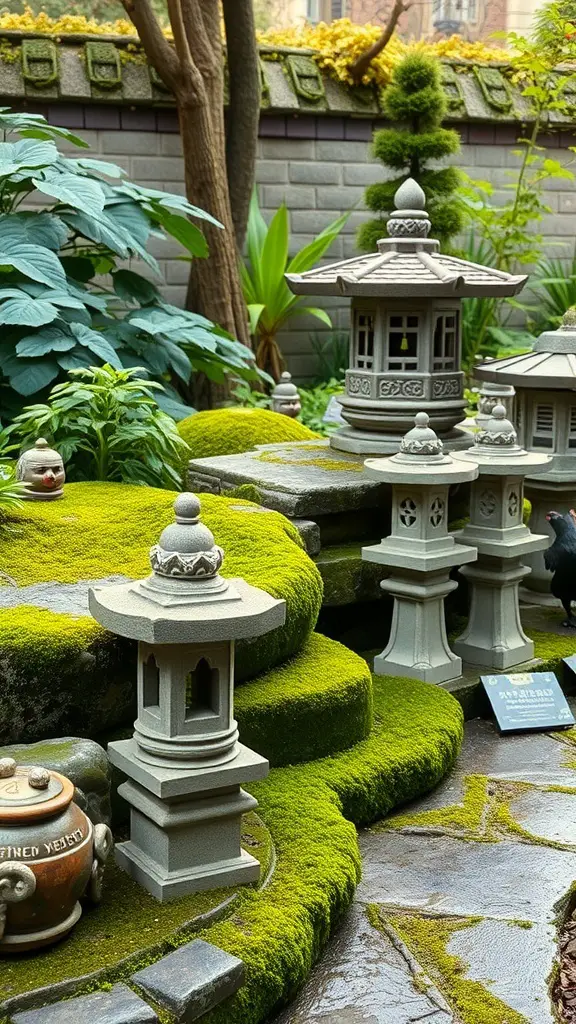
Stone lanterns are a classic feature in Japanese gardens. They add a unique charm and a sense of tranquility. These lanterns often come in various shapes and sizes, each telling its own story. In the image, you can see a few beautifully crafted lanterns surrounded by lush greenery and soft moss. The stone texture blends seamlessly with nature, creating a peaceful atmosphere.
Ornaments like these lanterns serve both functional and aesthetic purposes. They illuminate pathways at night and guide visitors through the garden. The soft glow from a lantern can transform the garden into a magical space after sunset. The careful placement of these elements enhances the overall design, making every corner inviting.
Incorporating stone lanterns into your garden design can be a delightful way to pay homage to traditional Japanese aesthetics. They invite contemplation and appreciation of nature’s beauty. Whether you choose a simple design or a more intricate one, these lanterns will surely elevate your garden experience.
Zen Rock Gardens
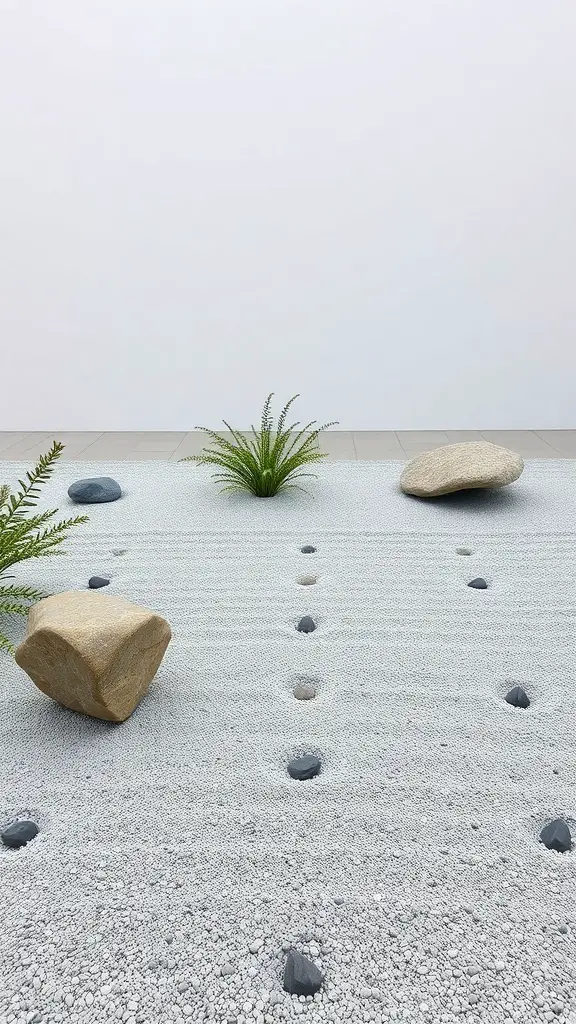
Zen rock gardens, or karesansui, are a beautiful blend of simplicity and tranquility. This image captures the essence of such a garden, showcasing a carefully arranged landscape of rocks and gravel. The soft, white gravel represents water, while the stones symbolize islands or mountains. This minimalist design invites contemplation and peace.
The gentle placement of the rocks and the sparse greenery adds to the serene atmosphere. The small plants peeking through the gravel bring a touch of life, reminding us of nature’s resilience. Each element in a Zen garden has a purpose, encouraging mindfulness and reflection.
Creating a Zen rock garden at home can be a rewarding project. Start with a flat space, choose your rocks, and lay down gravel. Arrange everything in a way that feels balanced to you. This space can become a personal retreat, perfect for meditation or simply enjoying a moment of calm.
Naturalistic Landscape Design
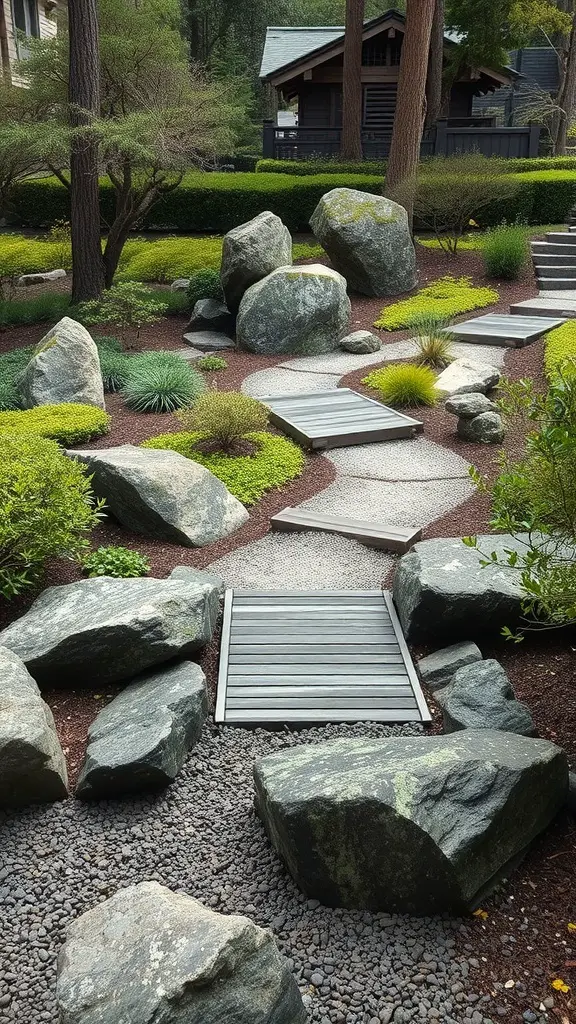
Japanese gardens are a beautiful blend of nature and design. The image showcases a serene garden with carefully placed rocks and lush greenery. The rocks create a natural feel, while the wooden pathways invite you to explore the space.
In this design, the use of rocks is significant. They symbolize strength and permanence. The arrangement of stones mimics natural landscapes, making the garden feel like a peaceful retreat. The greenery adds a touch of life, with different plants providing texture and color.
The pathways are not just functional; they guide visitors through the garden, encouraging a slow, mindful experience. This approach to design reflects a deep appreciation for nature, making every element purposeful.
Overall, this garden exemplifies naturalistic landscape design, where every stone and plant works together to create harmony. It’s a perfect example of how Japanese gardens can offer tranquility and beauty in any setting.
Meditation Spaces
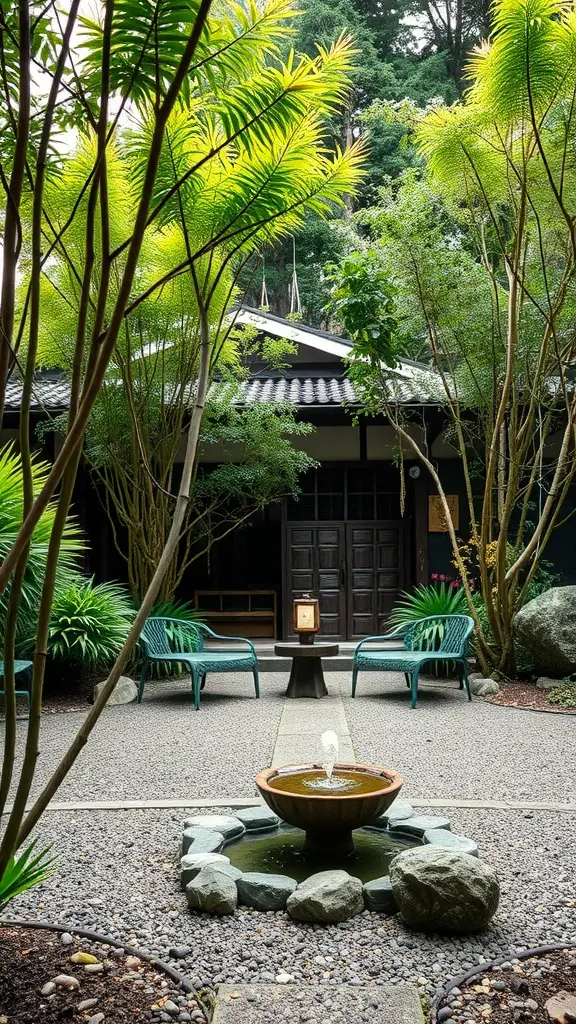
Japanese gardens are perfect for creating serene meditation spaces. The image shows a tranquil area with lush greenery and a calming water feature. This setting invites relaxation and reflection.
The gentle sound of water flowing from the fountain adds to the peaceful atmosphere. The stone arrangement around the fountain complements the natural elements, making it a great spot for quiet contemplation.
Seating areas, like the chairs shown, provide a comfortable place to sit and enjoy the surroundings. These spaces encourage mindfulness and a deeper connection with nature, making them ideal for meditation.
Incorporating plants and stones enhances the garden’s beauty. The greenery not only adds color but also creates a sense of privacy, allowing for a personal retreat. This design emphasizes simplicity and harmony, key aspects of Japanese garden philosophy.


